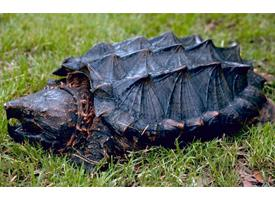
Poids et mesures
| Longueur | 80 cm |
|---|---|
| Poids | 25 kg |
Données biologiques
| Durée de vie | de 30 à 47 ans |
|---|
Description de l'animal
The Common Snapping Turtle (Chelydra serpentina) is a fascinating and prehistoric-looking reptile native to a wide range of habitats across North America. This species is renowned for its rugged appearance, formidable defensive mechanisms, and an almost dinosaur-like demeanor, making it a creature of intrigue and respect among wildlife enthusiasts and researchers alike.Physical Description:
The Common Snapping Turtle is characterized by a robust and muscular build. It possesses a large, heavy shell that ranges in color from dark brown to black, often covered in algae and mud, which camouflages it in its natural habitat. The carapace (upper shell) is relatively smooth compared to other turtles, with three low keels running down its length in younger individuals, becoming less pronounced with age. The plastron (lower shell) is quite small, providing little protection to the underside, a feature that likely contributed to the development of the snapping turtle's aggressive defense mechanisms. The head is large with a powerful beak-like jaw capable of delivering a strong bite. Its long tail, often nearly as long as the shell itself, is adorned with saw-toothed ridges, adding to its primitive appearance.
Size:
Adult Common Snapping Turtles are substantial in size, with males generally larger than females. They can reach shell lengths of up to 20 inches (50 cm) and weigh as much as 35 pounds (16 kg), with exceptional individuals exceeding these dimensions. Their size makes them the largest freshwater turtle species within their range.
Behavior:
Common Snapping Turtles are primarily aquatic, spending most of their time in the water where they are agile and graceful swimmers. They are often found in muddy-bottomed ponds, slow-moving streams, wetlands, and estuaries. Despite their aquatic preference, they do venture onto land, especially females during the nesting season when they lay eggs. They are known for their defensive behavior when out of water; if threatened, they can extend their necks with surprising speed and snap with considerable force, hence their name. However, in water, they tend to be more docile and will usually swim away from danger.
Diet:
These turtles are opportunistic omnivores with a diet that includes a wide variety of plant and animal matter. They consume fish, invertebrates, carrion, and aquatic vegetation, using their powerful jaws to capture and dismantle their prey.
Reproduction:
The breeding season for Common Snapping Turtles occurs in the spring. After mating, the female searches for a suitable nesting site, often traveling considerable distances overland. She lays a clutch of 20-40 eggs in a hole she digs in the ground. The eggs incubate for several months, with hatchlings emerging in the late summer or early fall. These young turtles are independent from birth and face numerous predators, including birds, mammals, and larger fish.
Conservation Status:
Currently, the Common Snapping Turtle is considered to be of Least Concern by the International Union for Conservation of Nature (IUCN), thanks to its wide distribution and large population. However, it faces threats from habitat destruction, pollution, and road mortality. Additionally, it is harvested in some areas for its meat, which is considered a delicacy, leading to concerns about over-exploitation.
In conclusion, the Common Snapping Turtle is a remarkable survivor from ancient times, embodying the resilience and adaptability of nature. Its unique features, behavior, and ecological role make it a key species in freshwater ecosystems across North America.
Animaux similaires
Nouvelles photos d'animaux
Top 10 des animaux
- Dolphin gull (Leucophaeus scoresbii)
- Diana monkey (Cercopithecus diana)
- Moustached guenon (Cercopithecus cephus)
- Galápagos tortoise (Geochelone nigra complex)
- Russian tortoise (Testudo horsfieldii)
- Japanese macaque (Macaca fuscata)
- Stone loach (Barbatula barbatula)
- Greek tortoise (Testudo graeca)
- Common flying dragon (Draco volans)
- Colossal squid (Mesonychoteuthis hamiltoni)
